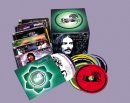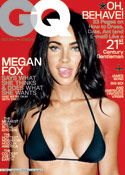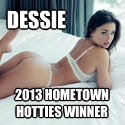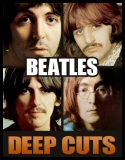Music Home / Entertainment Channel / Bullz-Eye Home
 Buy your copy from Amazon.com
Buy your copy from Amazon.com
| George Harrison: Dark Horse Years Released: Year |
It’s oft been joked that death is a hell of a career move, and George Harrison, sadly, was an excellent example of that. Copies of his out of print work, like the greatest hits album Best of Dark Horse 1976-1989 and the two Traveling Wilburys albums, jumped upwards of $40 on Half.com within minutes after the news broke of his passing. They were going for double that amount on eBay. Brainwashed, the solo album he was working on when he died, reached #18 on the Billboard album chart in a posthumous release. A living Harrison, by comparison, would not likely have cracked the top 100.
It is therefore difficult to witness the re-release of any dead artist’s back catalog without thinking of the Smiths song “Paint a Vulgar Picture,” which, true to its title, is a brutal portrayal of a fallen star, long deemed irrelevant by his record company, who’s treated like royalty upon his death. (“Reissue repackage, repackage, reevaluate the songs/Double pack with a photograph/Extra track and a tacky badge.”) Are the Dark Horse reissues any different? Unlike Morrissey’s imaginary character, Harrison truly was rock and roll royalty, and deserved better treatment than he was getting. Still, the label couldn’t help but add the mostly needless extra tracks. (Wisely, they skipped the tacky badge.) Here is the Bullz-Eye breakdown of the Dark Horse years.
Thirty Three & 1/3 (1976)
A mixed bag, though one with a lot of good stories to tell. The writer of the Chiffons’ “He’s So Fine” had just successfully sued Harrison for copyright infringement, citing the similarities between “He’s So Fine” and George’s “My Sweet Lord.” George, ever the smartass, wrote “This Song” in retaliation (“This tune ain’t bad or good and come ever what may/My expert tells me it’s okay.”), which became a Top-25 hit. Leadoff track “Woman Don’t You Cry for Me” has a nice sleazy groove thanks to its slide guitar, and “Pure Smokey” is a moving tribute to Smokey Robinson. Overall,
Thirty
Three & 1/3 isn’t bad, but as the debut of the Dark Horse imprint, it should have been better.
Bonus Track: “Tears of the World,” previously available only on the bootleg album
Pirate Songs.
Rating: ![]()
![]()
![]()
![]()
![]()
George Harrison (1979)
This was the lone above average work in Harrison’s canon for a good 15 years. “Blow Away” rightfully became one of his most successful solo singles, and “Love Comes to Everyone” and “If You Believe” are not far behind. The most curious track is the radical reworking of “Not Guilty,” which George wrote during sessions for the
White Album. Where the original version of the song smacked of vintage Jellyfish 20 years before that band’s formation (though, fittingly, right about the time its members were born), the version here is shockingly lazy, bearing little to no resemblance to what was actually one of George’s better songs.
George Harrison isn’t a classic, but it’s damn good, and the one true bright spot between
All Things Must Pass and Cloud Nine. Bonus Track: A demo version of “Here Comes The Moon.”
Rating: ![]()
![]()
![]()
![]()
![]()
Somewhere In England (1981)
Harrison suffered the indignity of watching Somewhere In England get rejected by the label, who instructed him to put some pep into it. The note clearly stuck in George’s craw, because the leadoff track, “Blood From a Clone,” is George’s stinging reply (“You need some oomph-papa, nothing like Frank Zappa/And not New Wave, they don’t play that crap”). The thing is, from listening to the rest of
Somewhere In England, it appears the label may have had a point; the album contains two covers of Hoagy Carmichael songs (!) and a preponderance of mid-tempo lite rock. The moments where Harrison does try to jazz things up, like “Teardrops” and “Save the World,” are filled with dreadfully dated synthesizers. The best cut here is “All Those Years Ago,” his ode to recently departed bandmate John Lennon. Featuring Paul, Ringo and producer George Martin, it was the last time the remaining Beatles would play together until 1996’s “Free as a Bird.”
Bonus Track: A demo version of “Save The World,” which redundantly appears right after the album version of “Save The World.”
Rating: ![]()
![]()
![]()
![]()
![]()
Gone Troppo (1982)
Abandon hope all ye who enter here. “Troppo” must be Swahili for “creatively bankrupt,” because
Gone Troppo is exactly that. “Wake Up My Love” sports synthesizers that would make Laura Branigan blush, and the title track is a half-assed piss-take on Jimmy Buffet. The story has it that George was bored with music and more interested in producing movies – indeed, “Dream Away” was written for Terry Gilliam’s “Time Bandits,” and wait until you see what pops up on
Cloud Nine – and that would certainly explain a lot. Still, one can’t help but wonder why the label didn’t step up again ala
Somewhere In England and tell the poor boy how awful his new album really was. For masochistic completists only.
Bonus Track: A demo version of “Mystical One.”
Rating: ![]()
![]()
![]()
![]()
![]()
Cloud Nine (1987)
Diehard fans and foes alike still shiver at the sound of #1 single “Got My Mind Set on You” (brilliantly parodied by Weird Al Yankovic in “This Song is Just Six Words Long”), but make no mistake,
Cloud Nine is easily Harrison’s best album since All Things Must
Pass. Teaming up with longtime Beatles worshiper Jeff Lynne was a smart move, forcing Harrison to be more practical than he had been on previous efforts. “Devil’s Radio” is one of George’s finest unsung moments, and “That’s What it Takes” is another gem. Lastly, there’s “When We Was Fab,” the closest Harrison came to embracing his legendary past, though Lynne can’t help but make it sound more like ELO than the Beatles. Still, it was a welcome return to form.
Bonus Tracks: Two tracks from the Harrison-produced movie “Shanghai Surprise” (yes,
that “Shanghai Surprise”), the title track and “Zig Zag.” Don’t laugh; the title track is better than you might think.
Rating: ![]()
![]()
![]()
![]()
![]()
Live in Japan (1992)
The track listing contains the best cross section of Harrison’s song catalog ever assembled on two CDs. His backing band includes Eric Clapton. So why is this album so flat?
Live in Japan was originally released in 1992, when the flavors of choice were grunge and obscenely overproduced pop.
Live in Japan definitely fits into the latter category, though to be truthful, half the grunge bands fit into the latter category as well. The simple joys of Beatles cuts like “Taxman” and “I Want To Tell You” are overwhelmed by a cadre of musicians paid to do something, anything, on each song, whether they’re needed or not. The other problem with
Live in Japan is Harrison’s voice, which, while never particularly strong, has never sounded weaker than it does here. There are moments where he rises above, like on “Give Me Love (Give Me Peace on Earth)” and “What Is Life,” and the set list is noteworthy for including
White Album deep cut “Piggies.” But in the end, Live in Japan is one of those instances where less would have been much, much more.
Bonus Tracks: None.
Rating: ![]()
![]()
![]()
![]()
![]()
Bonus DVD (available only on the Dark Horse Years box set)
The first section of the bonus DVD consists of Harrison’s promotional videos, which focus on the very beginning and very end of his Dark Horse tenure. The first clip, “This Song,” is a very funny parody of his “My Sweet Lord” lawsuit debacle. The “Crackerbox Palace” video may not be as zany, but still shows George’s sense of humor by having him start the video in a baby carriage. (Bonus points to George for exaggerating his pronunciation of “It’s true, it’s true” in the middle break ala Madeline Kahn in “Blazing Saddles.”) Following an uneventful clip of
George Harrison’s “Faster” are the four videos from Cloud Nine: two versions of “Got My Mind Set on You,” “When We Was Fab” and “This is Love.” Each clip has an optional intro by George explaining the origin of the song, though there’s no explanation for why the clip for “All Those Years Ago,” which received massive MTV airplay, was omitted.
The second section covers his work on “Shanghai Surprise,” which includes a shot of his cameo in the film as a Cab Calloway-type jazz singer. There’s a video of sorts for the title track, splicing footage from the movie with Harrison in the studio. Its addition is nice but by no means essential, nor is the footage from
Live in Japan that closes the DVD. If the DVD is supposed to be the deciding factor in whether someone chooses the box set over the individual albums, the executive producers certainly didn’t treat it that way.
Rating: ![]()
![]()
![]()
![]()
![]()
Best Bet
For those willing to dig deep, check out George Harrison and Cloud
Nine. For the rest, wait for the inevitable re-release of the single disc Best of Dark Horse
1976-1989, which in its original form contained tracks that are not on any of these six CDs. So yes, even if you buy the box set, there are still more songs to track down.
davidm@bullz-eye.com






